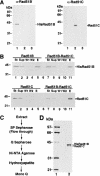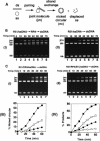Mediator function of the human Rad51B-Rad51C complex in Rad51/RPA-catalyzed DNA strand exchange
- PMID: 11751636
- PMCID: PMC312844
- DOI: 10.1101/gad.935501
Mediator function of the human Rad51B-Rad51C complex in Rad51/RPA-catalyzed DNA strand exchange
Abstract
Five Rad51-like proteins, referred to as Rad51 paralogs, have been described in vertebrates. We show that two of them, Rad51B and Rad51C, are associated in a stable complex. Rad51B-Rad51C complex has ssDNA binding and ssDNA-stimulated ATPase activities. We also examined the functional interaction of Rad51B-Rad51C with Rad51 and RPA. Even though RPA enhances Rad51-catalyzed DNA joint formation via removal of secondary structure in the ssDNA substrate, it can also compete with Rad51 for binding to the substrate, leading to suppressed reaction efficiency. The competition by RPA for substrate binding can be partially alleviated by Rad51B-Rad51C. This recombination mediator function of Rad51B-Rad51C is likely required for the assembly of the Rad51-ssDNA nucleoprotein filament in vivo.
Figures






Similar articles
-
Functional interactions among yeast Rad51 recombinase, Rad52 mediator, and replication protein A in DNA strand exchange.J Biol Chem. 2000 May 26;275(21):15895-904. doi: 10.1074/jbc.M910244199. J Biol Chem. 2000. PMID: 10748203
-
A single-stranded DNA-binding protein is needed for efficient presynaptic complex formation by the Saccharomyces cerevisiae Rad51 protein.J Biol Chem. 1997 Mar 21;272(12):7940-5. doi: 10.1074/jbc.272.12.7940. J Biol Chem. 1997. PMID: 9065463
-
Complex formation by the human Rad51B and Rad51C DNA repair proteins and their activities in vitro.J Biol Chem. 2003 Jan 24;278(4):2469-78. doi: 10.1074/jbc.M211038200. Epub 2002 Nov 8. J Biol Chem. 2003. PMID: 12427746
-
Assembly of RecA-like recombinases: distinct roles for mediator proteins in mitosis and meiosis.Proc Natl Acad Sci U S A. 2001 Jul 17;98(15):8411-8. doi: 10.1073/pnas.121046198. Proc Natl Acad Sci U S A. 2001. PMID: 11459983 Free PMC article. Review.
-
RAD-ical New Insights into RAD51 Regulation.Genes (Basel). 2018 Dec 13;9(12):629. doi: 10.3390/genes9120629. Genes (Basel). 2018. PMID: 30551670 Free PMC article. Review.
Cited by
-
Homologous recombination and human health: the roles of BRCA1, BRCA2, and associated proteins.Cold Spring Harb Perspect Biol. 2015 Apr 1;7(4):a016600. doi: 10.1101/cshperspect.a016600. Cold Spring Harb Perspect Biol. 2015. PMID: 25833843 Free PMC article. Review.
-
A molecular portrait of Arabidopsis meiosis.Arabidopsis Book. 2006;4:e0095. doi: 10.1199/tab.0095. Epub 2006 Jun 6. Arabidopsis Book. 2006. PMID: 22303228 Free PMC article.
-
S100A11 plays a role in homologous recombination and genome maintenance by influencing the persistence of RAD51 in DNA repair foci.Cell Cycle. 2016 Oct 17;15(20):2766-79. doi: 10.1080/15384101.2016.1220457. Epub 2016 Aug 11. Cell Cycle. 2016. PMID: 27590262 Free PMC article.
-
Differential and collaborative actions of Rad51 paralog proteins in cellular response to DNA damage.Nucleic Acids Res. 2005 Aug 10;33(14):4544-52. doi: 10.1093/nar/gki766. Print 2005. Nucleic Acids Res. 2005. PMID: 16093548 Free PMC article.
-
PRMT1 and PRMT5: on the road of homologous recombination and non-homologous end joining.Genome Instab Dis. 2023 Aug;4(4):197-209. doi: 10.1007/s42764-022-00095-w. Epub 2022 Dec 7. Genome Instab Dis. 2023. PMID: 37663901 Free PMC article.
References
-
- ————— Heteroduplex formation by human Rad51 protein: Effects of DNA end-structure, hRP-A and hRad52. J Mol Biol. 1999;291:363–374. - PubMed
-
- Beernink HT, Morrical SW. RMPs: Recombination/replication mediator proteins. Trends Biochem Sci. 1999;24:385–389. - PubMed
-
- Bianco PR, Tracy RB, Kowalczykowski SC. DNA strand exchange proteins: A biochemical and physical comparison. Front Biosci. 1998;3:D570–D603. - PubMed
Publication types
MeSH terms
Substances
Grants and funding
LinkOut - more resources
Full Text Sources
Molecular Biology Databases
Research Materials
Miscellaneous
